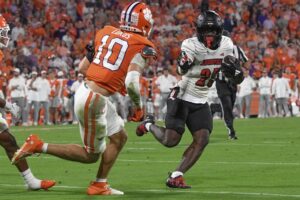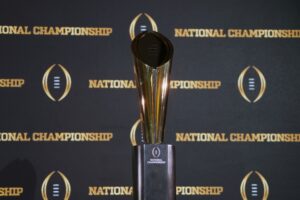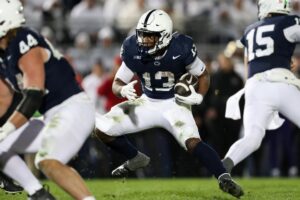Will the NCAA Impose Limits on Athlete Compensation?
We have been exploring the details of the NCAA’s foray into the student-athlete name, likeness, and image (“NIL”) compensation. We began with a general review of the NCAA’s announcement that it would permit NIL compensation. Then, we continued by examining the question of who might actually be handing over the checks to student-athletes for their NIL use. Now, we continue our series by focusing on another fundamental, but an important, question. Will the NCAA impose limits on athlete compensation?
As we discussed in our first part in this series, the NCAA asked its divisions to investigate NIL compensation. It directed the divisions to prepare their recommendations within 18 months. The NCAA’s decision, of course, responds directly to the California “Fair Pay to Play Act,” which we covered here, that prohibits schools from directing NIL compensation and that sets no outer limit to the NIL compensation. California’s broad law, however, is likely just the starting point of negotiations.
According to the NCAA, the proposals should be “consistent with the collegiate model.” Moreover, rules should advance several specifically delineated interests. Among others, modernization in NIL compensation should “make clear the distinction between collegiate and professional opportunities.” Similarly, rules should “make clear that compensation for athletics performance or participation is impermissible.”
The Case for Limits on Athlete Compensation
Admittedly, the answer to whether or not the NCAA will impose limits on NIL compensation depends on other questions that have not been answered yet. If, for example, the NCAA or the colleges decide to take on the role of negotiating and controlling NIL deals, then their willingness, desire, or ability to increases. If they relinquish this authority altogether, however, then the NCAA may impose no limits at all.
Locker-Room Impact
The NCAA expressed specific concern over turning college athletics into semi-professional leagues. Its own commentary, therefore, supports placing outer limits on NIL compensation. There are, of course, players like Zion Williamson or Tua Tagovailoa that could likely have inked substantial deals early in their respective college careers. But what impact might those deals have had on team chemistry? In the college atmosphere, how does the NCAA rationalize allowing players with six- or even seven-figure NIL deals to share a locker room with those making little to nothing? These kinds of issues counsel in favor of imposing limits on individual NIL compensation.
Preserving Competitive Balance
The NCAA also wants to ensure that competitive balance is preserved across its institutions. In a system with no compensation limits, how can the NCAA maintain that balance? Schools in California, for example, might benefit from advertising dollars coming from Silicon Valley or Hollywood. Oregon might benefit from their Nike connection even more than it does now. Meanwhile, schools in smaller markets could fall well behind their peers in this new type of arms race. Think about Nebraska, Kansas State, Iowa, Iowa State, and West Virginia, among others. Preservation of the existing balance, then, might favor NIL compensation limits.
Resisting Outside Influence
The NCAA has also resisted heavily the influence of agents and related professionals on student-athletes. Absent limits on NIL compensation, players would face tough decisions, especially in high-dollar contracts. Advertisers looking to license players’ NIL would no doubt seek to advance their own interests. As a result, athletes would need attorneys, agents, and managers to help advocate for their own interests. NIL compensation limits could guard against this.
The Case Against Limits on Athlete Compensation
NCAA Control
NIL compensation limits will require control over the mechanisms by which players get compensation by either the NCAA or schools. By exercising such control, the NCAA or its members may face difficulties under Title IX, a subject we will cover later in our series. Moreover, NCAA or college control and compensation limits would both fail to meet the requirements of the California Fair Pay to Play Act. Thus, unless California agrees to a compelled compromise or the NCAA is willing to disqualify its California teams, limits may not satisfy those pushing hard for NIL compensation.
Market Forces
Practically, limits may not be required either. Public relations consultant Steve Radick recently suggested that risks taken by brands relying on college athletes for their marketing may be even greater than the rewards offered. He further writes that, while some bigger brands may be willing to pay big money for the sure-fire investments, like Zion or Tua, most brands may be pushing for their teammates, the lesser-known players who could still strike big. As a result, market forces could easily dictate that larger NIL contracts or far and few between. And the vast majority of these contracts would be smaller stake contracts with athletes of local fame.
Disrupting Competitive Balance
Finally, most of the Power five schools may resist NIL limits for various reasons. Limits may actually exacerbate competitive imbalances that some say already exist. After all, we just saw Alabama-Clemson 3.0 for the title game last year. The teams that currently challenge for the playoff are perennial contenders. Alabama, Georgia, LSU, Ohio State, Oklahoma, Clemson, Notre Dame—these teams already win most of the high-profile recruiting battles. And their on-field results generally play out as those recruiting rankings would suggest.
With NIL limits, some might argue that these schools may simply continue to sell winning traditions, even if others may be willing and able to bring on third-party partners under a compensation system to close the gap. Indeed, to the extent, any of those schools already break the rules and get away with it, the shift of resources to control regulated NIL compensation may diminish the NCAA’s capacity to regulate other areas. As a result, behind-the-scenes shenanigans may continue unabated or even get worse.
Will the NCAA Impose Limits on Athlete Compensation?
In the end, the NCAA faces a difficult choice here. If it decides to impose limits on athlete compensation, then it faces various issues. But a completely unregulated scheme invites just as many problems. As we wrote in the second part of our series, the NCAA’s best play is to allow the individual conferences and schools to impose limits. If it does, the NCAA should beef up its enforcement of existing recruiting rules to help foster balance.
Allowing the conferences and schools to make the tough decisions allows for a greater balance of the athlete’s interests with those of the college programs for which they play. The varying rules may be difficult for student-athletes to balance, at first. But those rules also allow for athletic departments and coaching staffs to set rules and expectations unique to each program. And this, in our view, best serves to preserve the distinction between professional and college athletics. Yes, the world will change. But the product should not change too much if we allow conferences and schools to set their playing fields.






